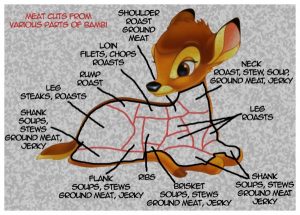I was a new doctoral student when cryptosporidiosis sickened over 400,000 people and killed 69 in Wisconsin in the spring of 1993.
 I had recently started the Food Safety Network, which was bringing daily updates to scientists and public health folks who usually had to wait 6 months for the U.S. Centers for Disease Control’s Morbidity and Mortality Weekly to arrive.
I had recently started the Food Safety Network, which was bringing daily updates to scientists and public health folks who usually had to wait 6 months for the U.S. Centers for Disease Control’s Morbidity and Mortality Weekly to arrive.
It may seem trivial now, but it was a big deal in its day.
Lotsa posers and copycats over the years, so we went to barfblog.com.
Later that year, cryptosporidiosis would sicken hundreds in Kitchener-Waterloo, where I was living with my young family.
Somehow, I was speaking about this to our home-renovator-contractor-and-therapist yesterday while he unplugged our kitchen faucet.
And then I got this.
Meg Jones of the Milwaukee Journal Sentinel writes that as doctors’ offices filled with Milwaukeeans suffering from a mysterious illness in 1993, Mayor John Norquist called a meeting with state and local officials.
Norquist asked state epidemiologist Jeffrey Davis whether he would drink a glass of Milwaukee’s water and when Davis said he would not, Norquist issued a massive boil water advisory that affected more than 1 million residents.
With decades of work in public health, Davis was the perfect person to figure out a little-known parasite cryptosporidiosis could be the culprit that sickened more than 400,000 people.
As state epidemiologist for the past four decades, Davis was Wisconsin’s doctor.
He was a medical sleuth who figured out the connection between toxic shock syndrome and tampons and helped determine the infectious agent transmitted by ticks that causes Lyme disease.
Davis, 72, died of pneumonia in Madison Jan. 16.
“Jeff’s knowledge of the literature helped identify the (Cryptosporidium) outbreak earlier. Cryptosporidiosis at that point was a pretty rare pathogen,” said State Public Health Veterinarian James Kazmierczak.
Knowing about a similar waterborne outbreak elsewhere in the U.S., Davis asked to see data on water quality in Milwaukee and noticed a spike in turbidity at the same time that people began to get sick. At the time, city water supplies were not tested for Cryptosporidium.
“Because of Jeff’s knowledge of what happened earlier with cryptosporidiosis, that became the leading suspect,” said Kazmierczak.
Davis grew up in Whitefish Bay and earned an undergraduate degree in chemistry in 1967 at University of Wisconsin-Madison and his medical degree in 1971 at the University of Chicago. He did his internship and residency in pediatrics in Florida and from 1973 to 1975 worked for the U.S. Centers for Disease Control and the South Carolina Department of Health.
After a stint at Duke University Medical Center, he returned to Wisconsin in 1978 as state epidemiologist and chief of the division of acute and communicable diseases. In 1991, his job title changed to chief medical officer and state epidemiologist for communicable diseases.
“He loved being a sleuth and medical detective, leading investigations of all sorts, from toxic shock syndrome to Legionnaires’ outbreaks, to the Cryptosporidium water supply outbreak, which was huge,” said his wife Roseanne Clark.
“He really was passionate about trying to figure out the source to reduce the impact on as many people as possible. He cared about the health of the people of Wisconsin.”
 Rare norovirus GIV foodborne outbreak, Wisconsin, USA
Rare norovirus GIV foodborne outbreak, Wisconsin, USA









